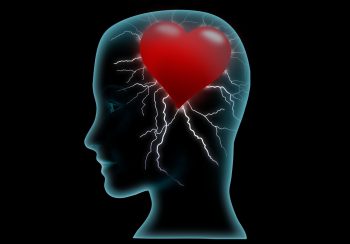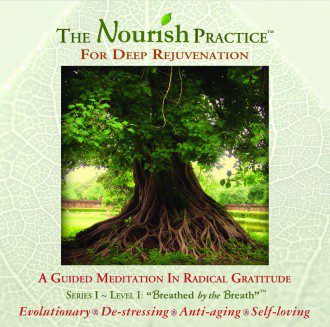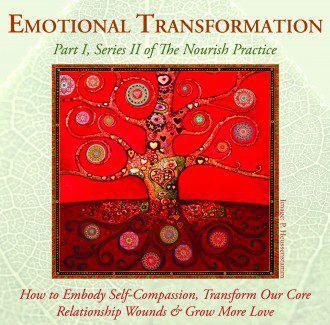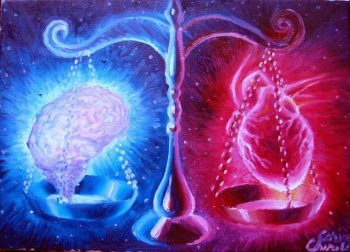March 24th, 2017
Contributing writer for Wake Up World
Our minds can be divisive (problematic) when it comes to feeling our true feelings and emotional healing. We all know the feeling of being made crazy by our thoughts. Yet, when employed skillfully, our minds are essential not only for emotional health but for mental health. Given that emotion has both a feeling-based aspect and a mental-cognitive aspect, both feeling and good thinking are needed for comprehensive, integral emotional healing.
Emotions are mediated not in our literal hearts inside our chest, but in the emotional center of our brain — the limbic system of our mid-brain, to be exact. This is the feeling part of our brain that orchestrates emotions in our body, including that sacred spot in our chest. So, when we use the word “heart” to describe our feelings and emotions, we do this based on what our experience feels like, because we feel emotions in the region of our chest.
But in reality, our “feeling heart” is in our brain, which triggers the release of hormones and neurotransmitters so that we viscerally feel emotion in our body. Emotions originate not in our chest or any other parts of our body beneath our anatomical head (which for now on I will just call “body” for simplicity), but in that mushy, fatty organ in our heads.
[pro_ad_display_adzone id=”110028″]
With this said, and ironically again, the brain can’t feel itself. We feel emotions in our body not because the emotions somehow live exclusively in our flesh and bone outside our head. Cellular emotional memory is therefore encoded largely in our brains, and in very specific parts of the brain. These brain memories in turn activate our peripheral nervous system, and motor neuron system (which initiates physical movement), which might be able to “remember” emotional experience (we’re not sure yet), in addition to the brain proper.
Our peripheral nervous system, nonetheless, is connected to the emotional centers of our brain. Therefore, physical stimulation of parts of our body that were connected with past emotional experiences can trigger a whole gamut of emotional experience, including memories, thoughts, feelings, and images. This is why emotions can be triggered both through mentally recollected memory and having part of our body sensitized or activated, such as during bodywork, making love, or a yoga session.
Coded memories of specific events form neurological connections between the brain and other parts of our body. When we perceive situations that remind us of the past, this can cause us to “feel” emotions in the present related to the past. Cortisol, epinephrine, and norepinephrine are secreted when we perceive fear. Adrenaline and noradrenaline levels rise when we are angered, and contribute to the physiological feeling of what we name anger. The latter function as neurotransmitters and hormones and are secreted both by the brain and kidney-adrenal system.
Indeed, what sets off most emotional experience is our perception, which is the activity of our mind, which involves our brains. Sometimes this perception is conscious, sometimes it’s unconscious. Fear is often unconscious because it’s the most fundamental emotion to ensure our survival in the face of danger, or perceived danger. If fear were always conscious we would likely be dead by now, because it would take too long for us to consciously decide to get out of the way of the oncoming car, bear, falling tree (or scary member of the opposite sex!) In an article on emotional mapping in the body, psychologist Lauri Numenmaa says:
“Say you see a snake and you feel fear … Your nervous system increases oxygen to your muscles and raises your heart rate so you can deal with the threat. It’s an automated system. We don’t have to think about it.”
Helpful Fear
While helpful for survival, there is a problem with this autonomic nervous system fear response if we are not aware. If we don’t use our minds to recognize fearful experiences about real threats from false threats we can end up with knee-jerk reactions to situations that are due to either improper perception in the present (á la mistaking a stick for a snake in the road) or past memories being triggered in the present. The latter is called fear conditioning and is why fear gets such a bad rap. We might also form beliefs based on our fear reactions. Sometimes these are helpful, sometimes not. If fear helps us avert real, in-the-moment danger, it’s helpful.
But if fear merely causes us to react unnecessarily in the present (when we are not truly in danger now) because the present reminds us of a similar scary situation in the past (PTSD), then fear is largely unhelpful (except perhaps for signaling to us that we need some help). For example, we might believe that all rustling in the bushes means trouble. Or, if anger caused us fear in the past, we might believe anger is only bad and never helpful. Or if our partner breaks an agreement or disregards us, we might fear that they will definitely hurt us in the same way again.
All these examples narrow our world, lead to false beliefs about reality, and to knee jerk reactions that limit our joy. If, however, we use good thinking to notice this unconscious joining of past fear to present reactivity, and thereby work through and/or reframe our unconscious beliefs and emotional reactions, we can heal and better manage this aspect of emotional experience and the problems it causes.
Because fear creates these apprehensions and unconscious avoidances, many denigrate or make fear a villain, just as they do the mind. Indeed, some say fear is the opposite of love, or can’t exist in the face of love. This is not true. Neurotic fear — learned historical fear acting up in the face of current non-threats that only remind us of the past — can prevent us from opening to love in the present. But helpful fear in response to real or realistic threats helps us love ourselves and one another by safeguarding what we care for, such as our very survival, clean air, and fresh water! And protecting our children, our health, and our human rights.
Fear inspires us to act [fight, flight, fawn (play possum), or freeze], so to cherish life, so that we can allay anxiety, which is the perpetuation of fear we can’t manage. When we ignore healthy fear, we deny our love of life by risking our lives to inaction in the face of danger, and by not being able to act with kindness and care. When we embrace fear, or at least welcome, allow, and get a little closer to it, we can discern its helpful from its unhelpful aspects. This way we employ its wisdom to protect what we love. All emotion, after all, has valuable information for us, and when we deny any emotion we can miss the message and injure life.
In sum, to throw the helpful aspects of fear out with the bathwater of neurotic fear is as big a mistake as considering the mind to be useless in love and emotional experience. Again, conscious fear in relation to real threats, or likely threats, helps us prepare for the future, for action, and should not be tossed out with our neurotic, unrealistic fears, and considered bad or demonized. This distances us from fear and allows it to wreak havoc unnoticed and unconsciously.
For this reason, especially, it’s crucial to review our reactions to events that cause us to react rather than respond. We might consider recruiting our brain’s neocortex to respond to emotional stimuli in order to moderate or reality-check the belief/s that support our emotional reactions. Our neocortex is the evolutionary newest and upper-most portion of our brains where critical thinking happens, representing yet another helpful use of good thinking for healing and for loving.
Granted, sometimes we can’t control our physiological fear reactions, and our anxiety can persist regardless of what we consciously realize. In such cases, we might have to recruit other resources and get support such as therapy, friends and family, a support group, herbs and supplements, lifestyle changes, and even medications.
Determining if our reaction is in response to something real can help us re-frame our experience and beliefs according to reality. How is this practical, you might ask? Say your boyfriend is out all night and doesn’t come home. You feel afraid. Maybe you’re afraid that he is out with another woman. Maybe you become angry in response to your fear that he’s cheating on you. If you react to your fear and anger and smash all his belongings, or yell at him, and then later discover that in fact he had a car wreck, you might have some amends to make to heal the consequences of your reactions! Good thinking, reflection, good communication, and reality-checking matter.
Heart-Mind
 All this is to say that we have to use our minds to help our “hearts.” “Heart” in this context is merely a metaphor for our feeling nature — again, which is mediated by our brains. In the final analysis, the term heart-mind might be most accurate to describe our feelings, because mind (cognition) and what we call “heart” (emotion/feelings) are inextricably linked. Yet, we can, for educational and self-improvement purposes, distinguish for discussion’s sake the mental aspects of emotion and the visceral or feeling aspect of emotion.
All this is to say that we have to use our minds to help our “hearts.” “Heart” in this context is merely a metaphor for our feeling nature — again, which is mediated by our brains. In the final analysis, the term heart-mind might be most accurate to describe our feelings, because mind (cognition) and what we call “heart” (emotion/feelings) are inextricably linked. Yet, we can, for educational and self-improvement purposes, distinguish for discussion’s sake the mental aspects of emotion and the visceral or feeling aspect of emotion.
There is ultimately no “heart” without mind, even in “pure” feelings of love, because we perceive, even unconsciously, with our minds, which information is computed in the brain beneath conscious awareness. Emotional experience is processed, relayed, and emanates from there, which is what is meant by the mediation of emotions in the brain. Yet, on a spectrum, there is the experience of love with more feeling than mental activity. But to some degree it seems the brain’s thinking is always to some degree involved in ways not immediately obvious to us.
The reason for any confusion on this topic might be because we have conflicting reports with regard to the experience of our emotions versus what actually happens physiologically during emotional experience. Because we feel some emotions like compassion and empathy in our chest and body does not mean this is where emotions originate or where they are mediated. While we may feel our emotions in our body, the anatomy and physiology of emotion, of which we are not consciously aware, operate behind the scenes, giving rise to experience. The hormone and neurotransmitter cascades (chain of physiological events) that cause us to feel emotion are released by our brain, which then stimulate other organs, especially our adrenals, to release hormones, such as adrenaline (epinephrine) and cortisol. Being aware of emotion in this regard is yet another aspect of how the mind is crucial for emotional awareness and for its healing.
Because we feel emotion, and especially love, in our anatomical heart area, we associate love (and other emotions) with the heart organ. And we use this term in daily life and therefore come to believe (through unconscious association) that love and emotion are actually in our physical heart. We now know, however, that romantic love lies in the brain, not the physical heart. Researchers have found that that “two brain structures in particular, the insula and the striatum, are responsible for tracking the progression from sexual desire to love.” Yet, we feel love in our heart because our brain activates this area through sensory and/or motor (action) neurons. But, in the end, what we feel in the literal region of our heart originates in perception and is mediated by the emotional centers of our brain.
None of this means that we should start trying to feel love in our brains! The takeaway is not to adjust our feelings of love, but to adjust our demonization of the mind. It’s instructional to learn what’s really going on with emotion, love, and perception to prevent us from making up good cop-bad cop stories about our hearts versus our mind, and feeling versus thinking. For, when we understand that our emotions are not really mediated in our anatomical hearts but in our brains (the limbic system of the midbrain, to be precise) and involve thinking (in the neocortex), then we aren’t tempted to contrast heart versus mind, and glorify the heart while diminishing the mind. In a captivating book on love, titled A General Theory of Love, author Dr. Thomas Lewis says: “The limbic system is associated with our emotions and the neocortex is associated with critical thinking. Both are operative in processing emotions.”
So, discussing “mind versus the heart” is tricky territory. If we substitute the word feeling for heart we end up with “mind versus feeling,” which actually is a more accurate way to discuss how feelings interface with thinking. We experience feeling in our body and we think about and perceive the world in our head, but ultimately both are united as body-mind, or heart-mind. Now, discursive thinking (as in thinking about what you will have for lunch or mulling over a decision) is different than the subconscious activity of perception. Discursive thinking, and especially obsessive and uncontrolled thinking, is that activity of the mind that can and often does get in the way of feeling and emotion. This is the defensive, denying, or imbalanced, “neurotic mind” (sometimes called the defensive ego) that can usurp all of our awareness, and is often employed as a defense against feeling discomfort or pain.
If we only feel our emotions without reflecting on them, then we easily can displace our emotions from the past onto the present, which is no fun for anyone. This is when our past usurps our present and how past wounds can sabotage our current relationships. When we can use our minds to trace current feelings to the past — aided by the knowledge that emotions can be triggered in the present that might have little to nothing to do with the present — then we can better heal the past, appropriate our emotional responses, and preserve goodness in the present. This is another example of how the mind is crucial for regulating emotional experience. Another is falling love: it’s often easy to go with our hearts, until it isn’t. Using discernment (thinking, analysis, wisdom) to restrain our hearts in love is often wise (more on that here).
Because we experience “neurotic mind” to interfere with good feelings, especially love feelings, we tend to make the mind a villain. Most of us have our version of tortured, obsessive, entitled, confusing, divisive, and defensive thoughts. Our mind, however, is crucial for managing and working with our emotions, not to mention living in accord with consensual reality and acting with decency. We just have to learn to put it to good use, which takes practice — mind-body practice.
So, when our thoughts are deranged and out of control, rather than make our mind the enemy, we can employ body-mind tools to help return our thinking back to being helpful, rather a hindrance. And if that doesn’t work, we can try to control our thinking and “not go there” as best we can. Distraction and taking frequent deep breaths also is helpful to get out of thinking ruts, and sometimes all we have in tough situations. We also might be helped by a walk, a shower, a jog, some yoga, or eating some protein. There are many ways to work with our mind to bring it back into harmony — as an ally — with our feeling “hearts.”
[pro_ad_display_adzone id=”110030″]
Coming From The Heart
When others speak of “coming from the heart,” I understand this metaphorically. I know what they mean because I feel love, appreciation, and affection in my chest too. But when we believe this literally, then we are tempted — as is ubiquitous today, especially in many spiritual circles — to pejoratively contrast our good, pure feeling hearts with our bad, annoying minds. Understanding that our feelings and love originate in the brain helps us not make these black and white distinctions, and ultimately preserves our full gamut of psycho-spiritual faculties. It also prevents our shadow from remaining underground where it can direct our lives unconsciously.
The feeling heart is not so pure, or good, when it’s unaided by its ally of good thinking, as in the projection and displacement of belief and emotion, described previously in the boyfriend example and just above. I notice people will often defend their pain and lack of critical thinking with statements such as “I’m just expressing myself,” or “I’m just sharing my feelings.” Well, there are responsible, skillful ways to express ourselves, that first include self-reflection, venting and vetting with supportive others. Just “sharing feelings” by unloading on someone before making sure we understand the facts that inform our emotion and their targets, and to what degree we are being triggered form the past, is crucial to not do violence onto others and to preserve loving connections.
So, when we understand that our brain and mind are integral to emotional experience, and more central to it than our anatomical hearts, then we don’t make the mind a villain and our literal heart a savior. Instead, and more accurately, we could contrast our feeling nature with our thinking nature. And it’s true, sometimes we can over-think things, for which we need to let go and just feel. Other times though, we need to think better, not emotionally reason (drawing definitive mental conclusions from feelings), and to better inform and realistically contextualize our feelings. This also prevents the dangerous myth that love is really just an emotion centered in our chest that has little to do with thinking and the rest of our nervous system and physiology. Actually, robust, comprehensive loving — especially acts of love — require us to think well, to perceive accurately, and to rely on our brains for the neurotransmitters and hormones to experience the feelings of love.
Because both mind and body-feelings are involved in emotion, both mind and body-feelings need to be involved in emotional healing. This means that we have to both re-experience our emotions in order to feel, process, and release them, and we have to use our good minds (not the divisive, defensive, denying, neurotic, and entitled ego-mind) to understand the context of our emotions. We use our minds, for example, to determine who is involved, what our choices are, to glean the facts and determine if our understanding is consistent with the facts, what we can learn from our mistakes, if our current feelings are in relation to what really happened, and what a current experience reminds us of from our pasts. For emotional healing we can also use our minds to name our emotions so we can remember and cross-reference other incidents when we felt “sad,” “anxious,” “afraid,” or “angry,” for example. This helps us context our current emotional states with past ones, so we can gain more perspective on our current situation and express our emotions skillfully and appropriately (while always feeling them, regardless).
At the end of the day, we may go on feeling and experiencing ourselves just as we always have. Except that when we place our hands on our heart we might smile in the back of our mind, knowing that we also are touching and feeling the deep folds in our brain responsible for the feel-good or feel-bad sensation inside our chest. We also will be less likely to denounce the mind as an enemy of our “heart,” because in large part, our feeling “heart” is in our brain! This way we welcome back any parts of us that we have relegated to the dog-house, like fear, critical thinking, and thoughts themselves. Healing the “heart,” then, is to heal the mind, and vice-versa. And fear, rather than the villain we make it out to be, tells us where and what needs our loving attention. As Rilke reminds us: “Perhaps all the dragons in our lives are princesses who are only waiting to see us act, just once, with beauty and courage.” This way, we recover the tools we need to live fuller, more integrated, connected, and harmonious lives.
The Nourish Practice

Jack Adam Weber’s “The Nourish Practice” is an easy, guided meditation-Qi Gong practice in radical gratitude and self-love. It is an Earth-based, body-centered practice — at once physiological and mythological — that is deeply relaxing and replenishing, especially for modern-day burn-out syndrome, and requires little physical effort. “The Nourish Practice” resets your nervous system and fosters a rich inner life.

You can purchase The Nourish Practice as a CD or Digital Download here.
The first installment in Jack Adam Weber’s new “Emotional Transformation” series, entitled “Healing from Heartbreak”, is also available here — a valuable guide to embodying self-compassion, healing and love.
About the author:
 Jack Adam Weber, L.Ac. is a Chinese medicine physician, author, celebrated poet, organic farmer, and activist for body-centered spirituality. He is also the creator of The Nourish Practice, an Earth-based rejuvenation meditation, and Healing from Heartbreak, the first installment in his “Emotional Transformation” series.
Jack Adam Weber, L.Ac. is a Chinese medicine physician, author, celebrated poet, organic farmer, and activist for body-centered spirituality. He is also the creator of The Nourish Practice, an Earth-based rejuvenation meditation, and Healing from Heartbreak, the first installment in his “Emotional Transformation” series.
Weber is available by phone or online for medical consultations and life-coaching.
You can connect with Jack at:
- Website: JackAdamWeber.com
- Facebook: Facebook.com/JackAdamWeber
- Twitter: Twitter.com/JackAdamWeber
- Email: [email protected]
Recommended articles by Jack Adam Weber:
- BREAKTHROUGH — Now Is Our Time
- The Modern Shaman: Fierce Love at the Frontier of Madness
- When We Love an Addict – Courage and the Limits of Compassion
- Arrogance in Relationships: How to Deal With and Heal It
- 11 Reasons Why Hippies (Not Psychos) Should Rule the World
- The Monsanto Years: Singer Neil Young Rips Into GMOs, Big Biz and Conformity
- ReVOLUTION: When Enough is Enough
- Sex – Truth and Dare, Pleasure and Purpose
- Relationships: The Costs of Staying When We Should Leave
- Yin Yang — Ancient Wisdom for Personal and Planetary Transformation
- Heartbreak – Loving Ourselves Through Difficult Times
- SELF-HONESTY: Where All Healing Begins
[pro_ad_display_adzone id=”110027″]







